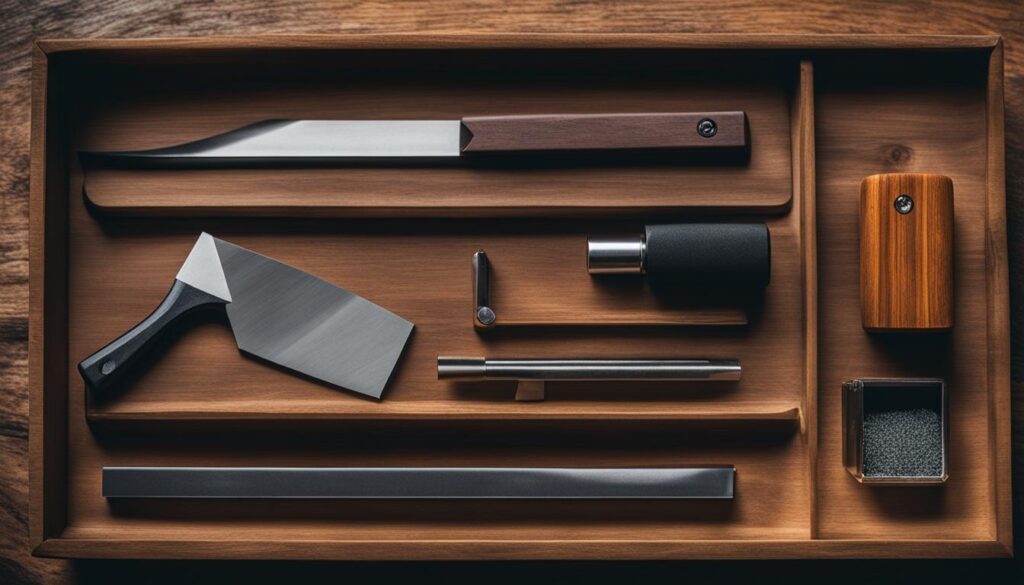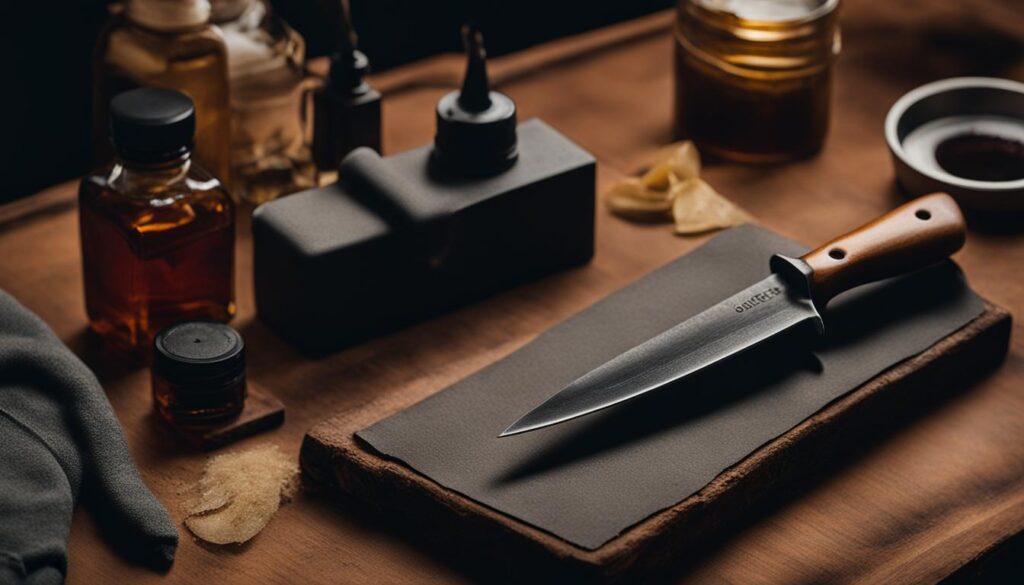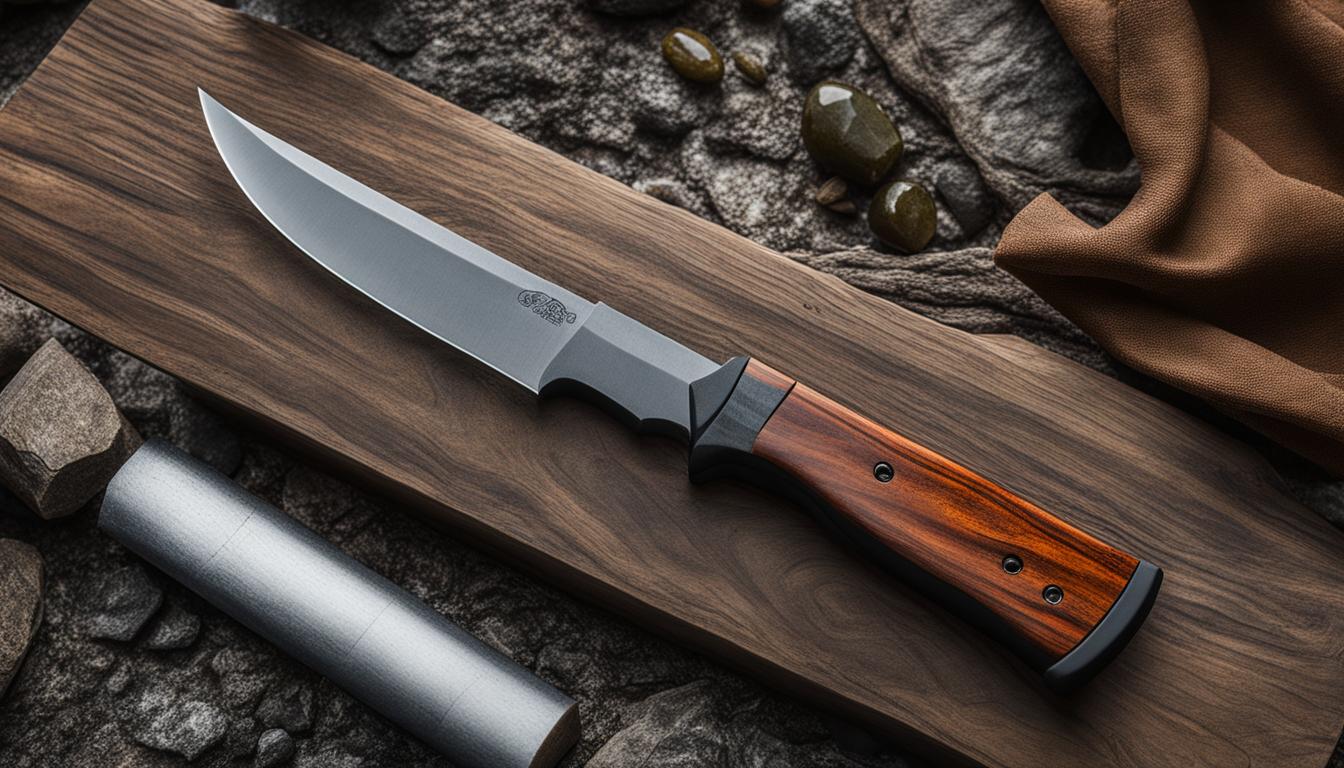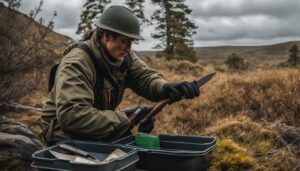Knife sharpening is an essential skill for hunting knife enthusiasts. It is important to prioritize safety while keeping your knives sharp. In this article, I will explore safe knife sharpening techniques and methods to ensure that you can maintain the edge of your hunting knife while minimizing the risk of accidents.
Key Takeaways:
- Safe knife sharpening techniques are crucial for hunters to maintain the effectiveness and safety of their knives.
- Choosing the right sharpening tools, such as knife sharpeners and sharpening stones, is essential for a successful sharpening process.
- Proper sharpening techniques, including maintaining the correct sharpening angle and using controlled strokes, are necessary for achieving a sharp edge.
- Implementing safety precautions, such as wearing protective gear and ensuring a stable workspace, is vital when sharpening knives.
- Storing and handling sharpened knives properly helps maintain their sharpness and prevents accidents.
The Importance of Sharp Knives in Hunting
Sharp knives play a crucial role in hunting, ensuring clean and precise cuts that are essential for a successful hunt. Hunting knives are designed to perform tasks such as field dressing game animals, cutting ropes, and preparing food. Having a sharp hunting knife not only makes these tasks easier and more efficient but also minimizes the risk of accidents and injuries.
When hunting, a sharp knife allows for clean and accurate cuts, reducing the chances of damaging the meat or leaving behind fragments in the animal’s body. Dull knives can cause the blade to slip, leading to unnecessary injuries or a poor field dressing job. A sharp hunting knife ensures a clean kill and facilitates the dressing process by enabling smooth and precise cuts through the animal’s skin, muscles, and joints.
Knife maintenance, including regular sharpening, is necessary to keep hunting knives in optimal condition. A dull knife requires more force to cut, increasing the risk of accidents. By regularly sharpening your hunting knife, you not only ensure safer handling but also prolong the life of the blade by preventing excessive wear and tear. A well-maintained hunting knife will serve you better in the field and make your hunting experience more enjoyable.
Remember, a sharp hunting knife is a vital tool for any hunter. It enhances your cutting performance, improves safety, and increases the efficiency of field dressing game animals. Investing time in sharpening and maintaining your hunting knife will pay off in the long run, allowing you to make the most out of your hunting adventures.
Table: Benefits of Sharp Knives in Hunting
| Benefits | Description |
|---|---|
| Improved Cutting Performance | A sharp hunting knife provides clean and precise cuts, enhancing your performance in the field. |
| Enhanced Safety | A sharp knife reduces the risk of accidents by ensuring better control and reducing the force required to cut. |
| Efficient Field Dressing | A sharp knife facilitates the field dressing process by enabling smooth and accurate cuts through the animal’s skin, muscles, and joints. |
| Prolonged Blade Life | Regular knife maintenance, including sharpening, helps prevent excessive wear and tear, prolonging the life of the blade. |
Choosing the Right Sharpening Tools
When it comes to sharpening your hunting knives, selecting the right sharpening tools is crucial for achieving optimal results. There are various options available, each with its own advantages and considerations. Let’s explore some of the most commonly used sharpening tools:
Knife Sharpener
A knife sharpener is a convenient tool that allows you to sharpen your hunting knives with ease. They come in different types, such as electric sharpeners, pull-through sharpeners, and sharpening systems. Electric sharpeners are quick and efficient, while pull-through sharpeners are portable and user-friendly. Sharpening systems provide more control and precision, making them an excellent choice for professionals or those who seek perfection.
Sharpening Stones
Sharpening stones, also known as whetstones, are traditional tools that have been used for centuries. They offer a versatile and hands-on approach to knife sharpening. Sharpening stones come in different grits, which determine the coarseness or fineness of the sharpening surface. Coarse grits are ideal for removing nicks and reshaping the blade, while finer grits are used for honing and polishing the edge. Using sharpening stones requires technique and practice, but it allows for greater customization and precision in the sharpening process.
It’s important to consider the type of knife you have and the level of sharpening required when choosing the right sharpening tool. Electric sharpeners or pull-through sharpeners may be more suitable for beginners or those who prioritize convenience. On the other hand, if you enjoy the hands-on approach and want to have complete control over the sharpening process, sharpening stones may be the perfect choice for you.

Now that we’ve explored the different sharpening tools available, let’s move on to Section 4 to learn about the proper sharpening techniques to achieve a sharp edge for your hunting knives.
Proper Sharpening Techniques
When it comes to knife sharpening, using proper techniques is crucial for achieving a sharp edge while ensuring safety. One of the key factors to consider is the knife sharpening angle. The angle at which you hold the knife against the sharpening tool will determine the sharpness and durability of the edge. It is recommended to maintain a consistent angle throughout the sharpening process to achieve optimal results.
Another important aspect of proper sharpening techniques is the use of controlled sharpening strokes. Whether you are using a sharpening stone or a knife sharpener, it’s important to apply consistent pressure and maintain a steady motion. Avoid using excessive force or applying inconsistent pressure, as this can lead to uneven sharpening and potentially damage the blade.
It’s worth noting that different knives may require specific techniques based on their blade geometry and design. For example, a hunting knife with a drop-point blade may require a different sharpening technique compared to a knife with a tanto blade. It is important to understand the specific sharpening requirements for your knife and apply the appropriate techniques accordingly.
Safety Precautions During Sharpening
When it comes to sharpening knives, taking proper safety precautions is of utmost importance. By following these safety guidelines, you can minimize the risk of accidents and ensure a safe sharpening process.
Protective Gear
It is essential to use appropriate protective gear when sharpening knives. This includes wearing cut-resistant gloves to protect your hands from accidental cuts. Additionally, safety goggles can shield your eyes from any debris that may be generated during the sharpening process.
Stable Workspace
Creating a stable workspace is crucial to prevent accidents while sharpening knives. Ensure that your work surface is sturdy and secure. Consider using a nonslip mat underneath your sharpening tools to prevent them from sliding or moving while in use.
Mindful Handling
Always handle knives with extreme caution and mindfulness. Keep your fingers away from the sharp edges and handle the knives by their handles. Avoid holding the blades or attempting to catch falling knives. By practicing proper knife handling techniques, you can reduce the risk of accidental cuts and injuries.
| Safety Precautions | Description |
|---|---|
| Wear Protective Gear | Use cut-resistant gloves and safety goggles to protect your hands and eyes. |
| Create a Stable Workspace | Ensure your work surface is stable and use a nonslip mat to prevent tools from sliding. |
| Handle Knives Mindfully | Avoid touching the sharp edges and only handle knives by their handles. |
By adhering to these safety precautions and demonstrating caution throughout the sharpening process, you can enjoy a safe and efficient knife sharpening experience. Remember, prioritizing safety is essential for both novice and experienced knife enthusiasts.


Storing and Handling Sharpened Knives
Properly storing and handling sharpened knives is crucial to maintain their sharpness and prevent accidents. By following these knife storage and handling guidelines, you can ensure that your knives remain in optimal condition and pose minimal risk.
Knife Storage
When it comes to storing sharpened knives, safety and accessibility are key considerations. It’s important to keep your knives in a safe and secure location, away from the reach of children and other potential hazards. A designated knife block or a knife sheath can be effective options for storage. These not only protect the sharp blades but also provide easy access when you need them for your hunting adventures.
Knife Handling
Proper knife handling is essential for maintaining the sharpness of your blades and ensuring personal safety. Always handle knives with care, holding them securely by the handle and keeping your fingers away from the blade. When working with a knife, make sure to maintain a stable grip and use controlled movements. Always cut away from your body and keep the blade pointed away from yourself and others.
Knife Safety
Knife safety should be a top priority when storing and handling sharpened knives. Never leave knives unattended or within reach of children or pets. Additionally, keep the blades clean and dry to prevent corrosion and maintain their sharpness. Regularly inspect the condition of your knives, checking for any signs of wear or damage. If you notice any issues, it’s important to address them promptly to ensure safe and effective use.
| Knife Storage Tips | Knife Handling Tips | Knife Safety Tips |
|---|---|---|
| Store knives in a safe and secure location, away from children and potential hazards. | Hold knives securely by the handle and keep your fingers away from the blade during handling. | Never leave knives unattended and keep them out of reach of children and pets. |
| Consider using a designated knife block or knife sheath for storage. | Cut away from your body and keep the blade pointed away from yourself and others. | Keep the blades clean and dry to prevent corrosion and maintain sharpness. |
| Ensure easy access to your knives when needed for hunting or outdoor activities. | Maintain a stable grip and use controlled movements while working with a knife. | Regularly inspect the condition of your knives for wear or damage. |
By following these guidelines for storing and handling sharpened knives, you can prioritize safety while keeping your blades in prime condition. Remember to always exercise caution and handle sharp knives with care.
Regular Maintenance for Sharp Knives
Keeping your hunting knives in optimal condition requires regular maintenance. This includes proper knife maintenance, regular cleaning, and occasional touch-up sharpening. By following these steps, you can ensure that your knives stay sharp and reliable, ready for your next hunting adventure.
Cleaning the Blades
After each use, it’s important to clean your hunting knife blades thoroughly. This helps remove any debris, dirt, or animal fluids that may have accumulated during field dressing. To clean the blades, use warm soapy water and a soft cloth or sponge. Gently wipe the blades, taking care not to apply excessive pressure or scrub too vigorously.
Once the blades are clean, dry them thoroughly to prevent moisture from causing rust or corrosion. You can use a clean, dry cloth or paper towel to dry the blades completely. Ensure all moisture is removed, especially in hard-to-reach areas such as the hinge or handle joints.
Touch-Up Sharpening
Even with regular maintenance, the edges of your hunting knife blades may become dull over time. Periodic touch-up sharpening can help maintain the sharpness of the blades between more extensive sharpening sessions. To perform touch-up sharpening, you can use a fine-grit sharpening stone or a knife sharpener specifically designed for touch-ups.
When touch-up sharpening, it’s important to follow the manufacturer’s instructions and maintain the correct sharpening angle for your particular knife. Using controlled sharpening strokes, gently run the blade along the sharpening stone or through the knife sharpener. Be mindful of the sharp edge and take precautions to prevent accidents.
| Benefits of Regular Maintenance | Key Steps for Regular Maintenance |
|---|---|
| 1. Maintains sharpness for precise cuts | 1. Clean blades after each use |
| 2. Prevents rust and corrosion | 2. Dry blades thoroughly |
| 3. Extends the lifespan of your knives | 3. Perform touch-up sharpening as needed |
| 4. Ensures reliable performance in the field | 4. Follow manufacturer’s instructions |
Regular maintenance is vital to keep your hunting knives in optimal condition. By following proper knife maintenance practices, cleaning the blades after each use, and periodically performing touch-up sharpening, you can ensure that your knives remain sharp, reliable, and ready for any hunting situation.
Conclusion
Safe knife sharpening techniques are essential for maintaining sharp knives and ensuring a successful hunting experience. By prioritizing safety and following proper sharpening methods, you can keep your hunting knives in optimal condition.
Remember, sharp knives are crucial for clean and precise cuts while minimizing the risk of accidents. Regular maintenance, including sharpening, is necessary to keep your hunting knives sharp and effective in the field.
Choose the right sharpening tools for your specific needs, such as knife sharpeners or sharpening stones. Practice proper sharpening techniques, including maintaining the correct sharpening angle and using controlled strokes. And don’t forget to take safety precautions, such as using protective gear and creating a stable workspace.
In conclusion, by implementing safe knife sharpening practices, maintaining sharp knives, and practicing regular care, you can ensure the longevity and effectiveness of your hunting knives. So, stay sharp, stay safe, and enjoy your hunting adventures!
FAQ
Why is knife sharpening important for hunting knife enthusiasts?
Knife sharpening is important for hunting knife enthusiasts to ensure clean and precise cuts, improve effectiveness while field dressing game animals, and maintain optimal knife condition.
What tools should I use for safe knife sharpening?
It is essential to select suitable sharpening tools such as knife sharpeners or sharpening stones based on the type of knife and desired level of sharpening.
What are the proper sharpening techniques I should follow?
Proper sharpening techniques include maintaining the correct sharpening angle and using controlled sharpening strokes. Different knives may require specific techniques.
How can I ensure safety while sharpening knives?
To ensure safety while sharpening knives, use protective gear, maintain a stable workspace, and be mindful of the sharp edge throughout the sharpening process.
How should I store and handle sharpened knives?
Store sharpened knives in a safe and secure manner, away from children and potential hazards. Handle knives with care, always keeping the blade pointed away from yourself and others.
How often should I perform knife maintenance?
Regular knife maintenance, including cleaning the blades after each use, periodic honing, and touch-up sharpening, is necessary to keep knives sharp and in optimal working condition.





